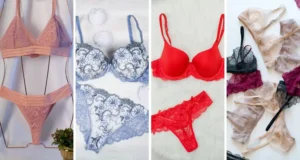Women wear panty liners for various reasons. These thin and absorbent pads provide solutions to many feminine hygiene issues. Panty liners are designed to make women feel fresh and protected all day long.
For starters, panty liners prevent embarrassing leaks and stains. They absorb light vaginal discharge, menstrual flow, and even urine dribbles, keeping underwear clean. Women don’t have to worry about unexpected spotting ruining their outfits or causing awkward wet patches. Pantry liners give women added protection and peace of mind during their period or on regular days.
Panty liners also promote hygiene and soothe discomfort. They prevent excess moisture build-up, absorbing sweat, discharge, and post-coital fluids. This helps women feel dry and prevents irritation down there. Changing panty liners regularly maintains freshness and prevents bacterial overgrowth. For some women, wearing panty liners daily helps them feel clean all the time.
By choosing the right absorbency, panty liners can meet different needs at different times. They may be a small product, but they can make a big difference to a woman’s comfort and self-assurance. So, let’s go in a more detailed view.
Why do females wear panty liners?
Protection against fluids and odors
Females mainly wear panty liners to protect against uncomfortable vaginal discharge and odors. Liners absorb excess fluids that moisten the intimate area, causing an unpleasant odor.
The liners trap these fluids, helping women maintain freshness and cleanliness. Panty liners deliver twofold advantages – they keep women feeling dry and confident by shielding the fluids and absorbing any wetness.
This absorptive function aids in keeping underwear stain-free and in preventing irritation due to prolonged exposure of delicate skin to moisture. Panty liners are especially helpful during menstrual and postpartum periods when discharge volumes are higher.
Regularly changing liners at least every three to four hours allows females to uphold hygiene standards and curb odor.
Ultimately, panty liners ensure peace of mind for women by guarding against vaginal fluids and malodors throughout their busy days.

Maintaining hygiene and preventing infections
Some females wear panty liners primarily to maintain intimate area hygiene and prevent infections. Panty liners absorb excess vaginal discharge, keeping the sensitive skin dry and reducing the risk of bacterial and fungal growth that can cause infections.
They also trap moisture and bacteria from sweat, which otherwise can breed harmful germs. Women avoid conditions like bacterial vaginosis and yeast infections by soaking up fluids and regularly changing liners.
For optimum hygiene, Panty liners should be replaced at least every three to four hours.
Overall, wearing panty liners helps females maintain a clean and healthy intimate area by absorbing fluids that can encourage infection when left unattended.
Comfort and reducing friction/ irritation
Many females wear panty liners for comfort. Liners reduce friction between thighs and delicate skin that occurs due to physical activity or tight clothes.
The liners create a thin barrier that absorbs sweat and vaginal discharge, decreasing irritation. The material used for liners is soft and flexible, so they fit well without being noticeable.
When worn daily, liners boost comfort levels and minimize discomfort normally associated with exercise, long work days, or summer heat. Liners allow women to go about their routines unfettered by slippage, chafing, or moisture buildup.
Overall, panty liners enhance women’s comfort and convenience by diminishing friction and irritation.
Postpartum bleeding
New moms wear panty liners during postpartum bleeding episodes. After childbirth, females lose blood and discharge tissues through lochia for several weeks.
Panty liners can be useful to absorb the heaviest postpartum discharge during the initial lochia rubra stage and the lighter flow during lochia serosa.
However, postpartum pads designed for the heavier flow of fourth-trimester recovery are often more convenient due to features like longer length and thickness.
Panty liners provide additional protection during random episodes of lochia alba bleeding.
Though helpful, panty liners are usually insufficient during the heavy flow of initial postpartum discharge. Hence new moms often prefer specific postpartum pads for optimal comfort and coverage.
Menstrual cycle protection
Some females wear panty liners during their menstrual cycle for added protection. Liners shield against unexpected leaks and stains from light menstrual flow. They are made to lie gently against the intimate area, absorbing spotting that occurs between periods.
When worn along with sanitary pads, liners offer a second layer of protection against leaks. This is especially useful while sleeping during periods when heavier flows occur.
During their period, women replace liners regularly along with changing pads to maintain freshness and hygiene.
In summary, panty liners contribute an extra measure of security from surprises associated with phases of a woman’s menstrual cycle characterized by erratic flow.
Everyday use for freshness and hygiene
Many females wear panty liners daily as part of their feminine hygiene routine. Using liners regularly helps women feel clean and fresh throughout the day.
Liners absorb vaginal discharge that naturally occurs, keeping the intimate area dry. This helps prevent bacteria overgrowth that can cause odor.
Regularly changing liners also trap sweat and other impurities that build up from daily activities. Everyday liners help maintain antibiotic underwear by catching unnoticed spots or leaks.
Overall, females who wear panty liners daily benefit from the convenience and peace of mind of knowing they remain clean and odor-free all day.
Absorbing vaginal discharge
Females wear panty liners primarily to absorb the natural vaginal discharge. The discharge is a normal, healthy part of a woman’s anatomy that helps keep the pH balance and cleanse the vagina.
However, excessive discharge can make undergarments damp and cause an unpleasant wet feeling for women. Panty liners are therefore used to wick away the discharge, keeping the vaginal area dry and itch-free. This allows females to feel fresh and confident throughout the day.
Liners trap vaginal fluids, controlling unwanted leakage and odor. As a result, underwear stays clean and stain-free. Regular changing of liners every few hours is key to avoiding infections and maintaining optimal hygiene.
In summary, absorbing and managing vaginal discharge is one of the main benefits that panty liners provide to females.

Preventing unexpected spotting
Some females wear panty liners to catch unexpected spotting between periods and after sex. Spotting refers to light vaginal bleeding at unexpected times.
For women who regularly experience spotting, liners prevent leaks that stain underwear. Liners lie discreetly against a woman’s anatomy, absorbing any spotting that occurs between regular periods.
They also trap vaginal discharge that typically accompanies spotting. When spotting follows intimacy, liners trap post-coital discharge, resulting in a more hygienic and comfortable intimate area for women.
Liners shield against spotting throughout the month, ensuring peace of mind. Regular change avoids bacteria growth.
In summary, panty liners are essential to feminine care for women prone to random spotting outside of their normal period. They safeguard against unwanted staining and facilitate hygiene.
Backup for tampons or menstrual cups
Some females wear panty liners as an additional layer of security when using tampons or menstrual cups. Neither tampons nor cups offer perfect leak-proof protection during heavy flow days.
As a backup, liners absorb any unexpected overflow that escapes these period products. Liners trap blood and mucus, shielding underwear from stains. This provides comfort and confidence to women who prefer tampons or cups.
Liners also catch discharge resulting from the removal of period products. The thin, flexible design of liners ensures discreet coverage without bulk. Regular changing of liners ensures optimal hygiene when used with tampons or cups.
In summary, panty liners provide backup protection and peace of mind for females using alternative period methods.
Preventing chafing
Some females wear panty liners to minimize chafing of the thighs and intimate areas. Though not specifically designed for this purpose, liners provide a thin barrier that reduces friction between rubbing surfaces.
This is particularly useful for women during hot weather when sweat is a lubricant exacerbating chafing.
Liners also absorb discharge that otherwise makes skin surfaces slippery and prone to irritation upon rubbing together. While helpful, panty liners alone are not always enough to prevent severe chafing for some women, especially during high-impact exercises.
Products like anti-chafing shorts, cream, and moisture-wicking underwear designed to minimize chafing tend to perform better.
Still, panty liners provide a simple, everyday solution for women prone to light irritation and redness from thigh chafing caused by daily activities. They form a comfortable first line of defense against chafing by reducing thigh friction.
Feeling more confident
Many females wear panty liners to boost their confidence levels, especially during times when vaginal discharge is common.
Liners provide peace of mind by absorbing any discharge that can otherwise leak and stain undergarments. This allows women to feel fresh and dry instead of self-conscious about potential odor or wetness.
By trapping vaginal fluids, liners help maintain hygiene which women rely on to feel confident.
Liners also guard against unexpected spotting that can occur at any time. The thinness and flexibility of liners ensure discreet, invisible protection without bulk or noticeable panty lines.
Combined with regular changing, liners become integral to a woman’s daily feminine care routine to keep her feeling poised and self-assured.
In summary, panty liners’ comfort, hygiene, and leak protection lift women’s confidence by alleviating worries related to vaginal discharge, spotting, and stains.
Absorbing light menstrual flow
Females wear panty liners during their period, specifically on light-flow days. Liners absorb the initial onset of menstruation, known as pre-flow, when spotting begins before the full flow starts.
This protects underwear from stains. Mid-cycle, when blood flow decreases at the end of a period, liners trap residual discharge, preserving hygiene.
Women experiencing a light period rely on liners for the duration in place of pads. The flexibility and thinness of liners ensure comfort without bulk, making them suitable for light menstruation. Regular replacement is important, as liners have limited absorption capacity.
In summary, liners provide optimum convenience and discretion for females experiencing light menstrual bleeding at the beginning, middle, or end of their cycle. They shield underwear from light blood and mucus discharge.
Bladder leakage protection
Some females wear panty liners to protect against minor bladder leaks and incontinence. Liners trap small amounts of bladder leakage, absorbing unexpected urinary accidents. The liners dry undergarments and preserve a woman’s confidence by shielding staining.
However, panty liners are best suited for light bladder leakage since they are thin and offer limited absorption. For moderate to heavy incontinence, incontinence pads are more effective due to their longer length, higher absorbency, and bladder leak guards.
Incontinence pads are specially designed to accommodate larger volumes of urine release.
While panty liners provide some degree of protection against minor accidents, they should be replaced regularly to maintain hygiene and avoid skin irritation.
For females with significant bladder control issues, incontinence pads tend to offer more targeted solutions that minimize disposable pad changes and laundering inconvenience.
Post-intercourse use
After having sex, females wear panty liners to absorb excess vaginal fluids and remain hygienic and dry. Liners trap residue left behind after intimacy that can leave women feeling damp and uncomfortable.
Traditionally known as post-coital discharge, these fluids include a mix of spermatic fluid, vaginal secretions, and cervical mucus. Panty liners soak up this discharge, preventing it from soaking into underwear and ruining the intimate experience.
This allows women to regain their dignity and composure after intercourse without rushing to wash up.
The liner absorbent materials wick fluids away from the intimate area while improving airflow and reducing moisture buildup that can cause odor and infections. Regular changing of liners post-intercourse ensures optimal hygiene.
In summary, panty liners provide discreet protection and convenience for women, trapping excess bodily fluids after sex and letting them go about their day feeling clean and confident.
Spotting during pregnancy
Some pregnant women wear panty liners to absorb spotting that they may experience. Spotting during pregnancy refers to a small amount of vaginal bleeding or blood when a woman is not having her period. It is quite common, affecting up to 30% of pregnant women.
Panty liners trap spotting before it worsens. They provide a barrier that shields clothes from any blood that does leak.
However, heavy or prolonged bleeding requires medical care since it may indicate a serious problem.
Health experts distinguish between spotting and bleeding during pregnancy. Spotting involves minor blood loss that does not soak a full liner.
Bleeding fills or saturates a liner and indicates a larger volume of blood loss. Because of this distinction, pregnant women with spotting can utilize liners, while those with bleeding may need maternity pads.
In summary, though panty liners can be useful for absorbing light spotting that may occur during pregnancy, any heavy or prolonged vaginal bleeding warrants immediate medical attention.

Summary
Panty liners offer a range of benefits for women’s feminine hygiene. They prevent leaks and stains, absorbing vaginal discharge, menstrual flow, and urine dribbles.
Panty liners promote hygiene and comfort by preventing moisture build-up and irritation. They are accommodating during menstruation and postpartum periods. Regularly changing liners ensures freshness and prevents infections.
Panty liners provide added protection and confidence, absorbing fluids and odors. They also serve as a backup for tampons or menstrual cups, reducing chafing and preventing unexpected spotting.
Pantry liners can absorb light spotting during pregnancy, but heavy or prolonged bleeding requires medical attention. Wearing panty liners daily maintains freshness and hygiene, absorbing natural vaginal discharge and preventing bacteria overgrowth. They are suitable for light menstrual flow, offer bladder leakage protection, and are used post-intercourse to absorb excess fluids.
Panty liners can also be helpful during spotting episodes in pregnancy. While panty liners have their limitations, they are a convenient and discreet solution for women’s hygiene needs.
FAQ
Are reusable panty liners safe?
Yes, reusable panty liners are generally considered safe to use. They are made without the use of harsh chemicals, and many of them are made with organic or natural materials. Additionally, they can be comfortable, highly absorbent, and odorless.
Can I use panty liners for urine leakage?
Yes, panty liners can be used for light bladder leaks or light urinary incontinence. However, it’s important to note that panty liners are designed to absorb much less fluid than pads designed for incontinence. For more significant leakage, it is recommended to use incontinence pads or underwear that are specifically designed for incontinence, as they have better absorbency and odor control.
Are panty liners for periods or discharge?
Panty liners can be used for both periods and vaginal discharge. They are designed to absorb daily vaginal discharge or perspiration and can be used as a backup for unexpected periods or for light flow days at the beginning or end of a menstrual cycle. However, panty liners are not designed to be used in place of menstrual pads for heavy-flow days.
When did panty liners come out?
While the concept of panty liners dates back to ancient times, modern, commercially available panty liners were introduced in the early 1970s. Over the years, panty liners have evolved to include a variety of sizes, shapes, and materials to meet different needs and preferences.
Do panty liners stop smell?
Yes, some panty liners are specifically formulated to help neutralize vaginal odors and can be effective at masking odors caused by daily vaginal discharge, perspiration, or light bladder leaks.




